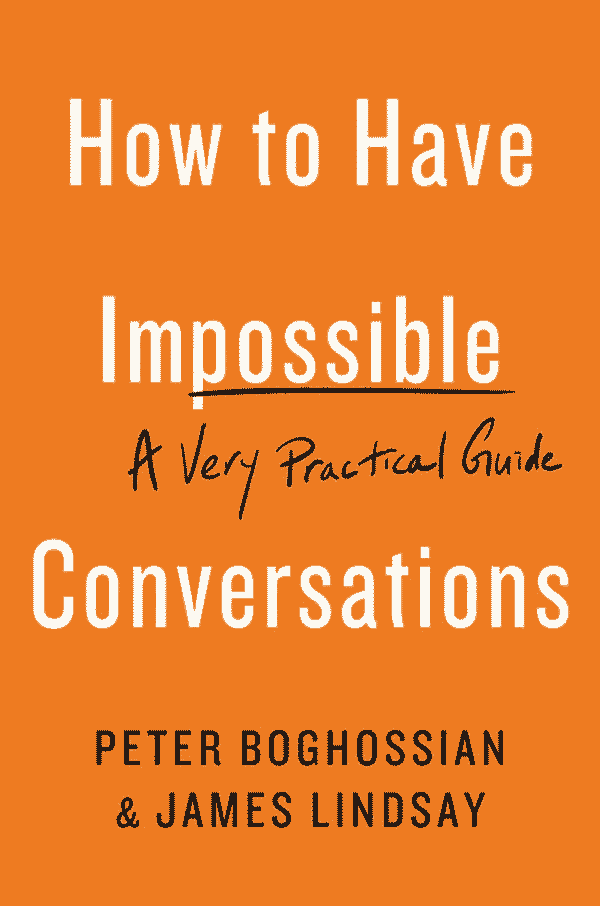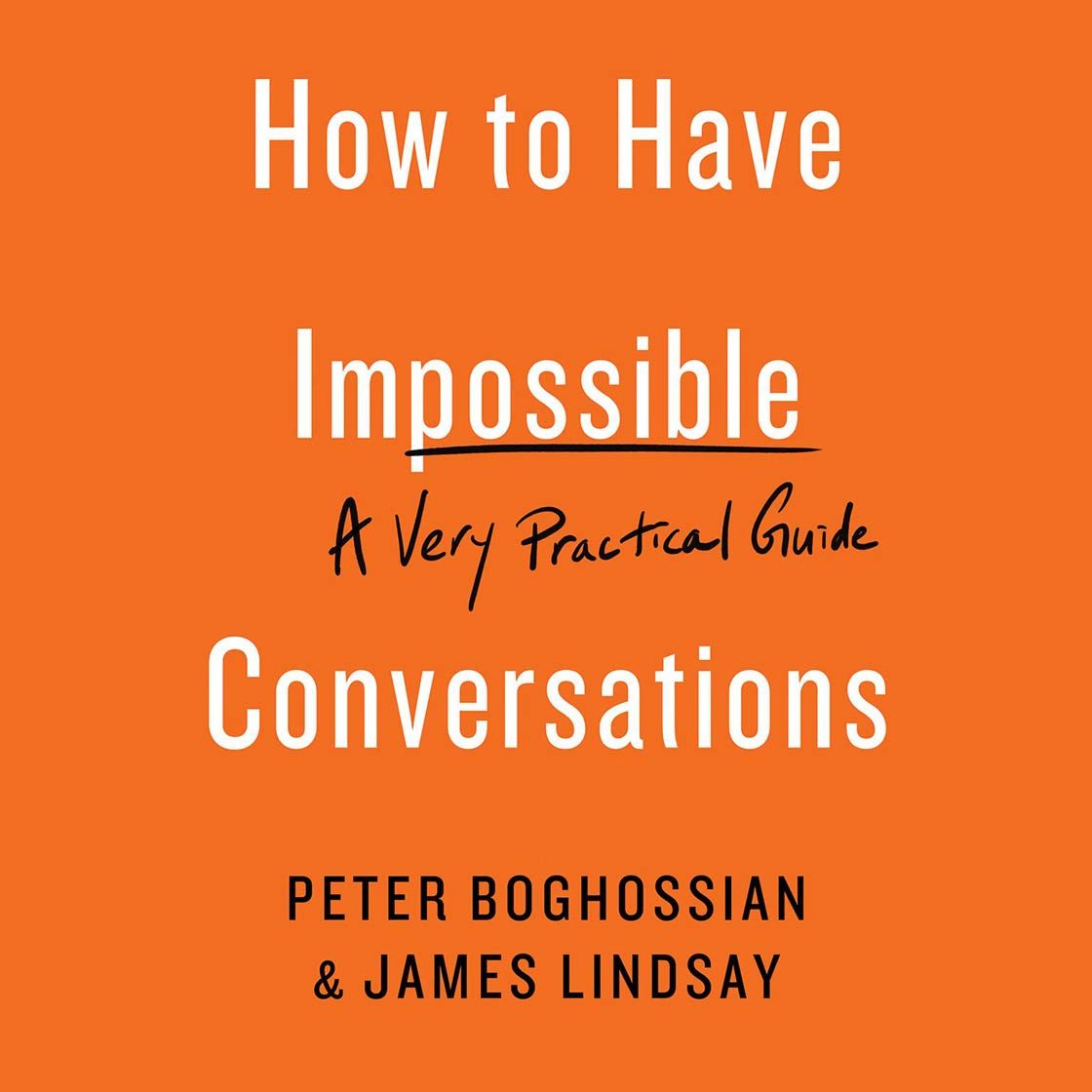The following excerpt is from a book about how to communicate effectively with people who hold radically different beliefs. We live in a divided, polarized era, and we’re not talking with each other. The repercussions of this are vast and deep, including the fear of speaking openly and honestly, an inability to solve shared problems, and lost friendships.
IIn this excerpt, taken from Chapter 5 of How to Have Impossible Conversations: A Very Practical Guide, we provide some tools to help people navigate contentious conversations.
Keep Rapoport’s Rules
The Russian-born American game theorist Anatol Rapoport had a list of rules for offering disagreement or criticism in conversations. These rules are now known as Rapoport’s Rules, and they have been described by the American philosopher Daniel C. Dennett as “the best antidote [for the] tendency to caricature one’s opponent.” Dennett neatly summarizes Rapoport’s Rules in his book Intuition Pumps and Other Tools for Thinking. If your goal is to engage someone successfully, take these steps in this order:
- Attempt to re-express your target’s position so clearly, vividly, and fairly that your target says, “Thanks, I wish I’d thought of putting it that way.”
- List any points of agreement.
- Mention anything you have learned from your target.
- And only then are you permitted to say so much as a word of rebuttal or criticism.
Adhering to Rapoport’s Rules can be difficult, especially in a heated discussion, but it will significantly advance the civility and effectiveness of your conversations.
Avoid Facts
Christian fundamentalist and Biblical Creationist Ken Ham is responsible for the Ark Encounter, a 510-foot (155 meters) full-size Noah’s ark in Grant County, Kentucky. Ham is the perfect example of someone who cannot be swayed by facts. He believes the Genesis flood narrative literally and incorrigibly. In a public debate with science popularizer Bill Nye in February 2014, both Ham and Nye were asked what would change their minds about creationism and evolution. Nye said “Evidence,” and Ham said, “Nothing.” Ham has explicitly stated that there’s no evidence that would cause him to revise his beliefs. Ham is not missing a piece of evidence that would cause him to change his mind; rather, he cannot be swayed by evidence, including rigorous peer-reviewed scientific studies. For him, the issue is settled. To engage someone like Ham, you have to avoid facts.

Excerpted from How to Have Impossible Conversations: A Very Practical Guide, by Peter Boghossian and James Lindsay, published by Da Capo Lifelong Books, an imprint of Perseus Books, LLC, reprinted with permission. Copyright © 2019 by Peter Boghossian and James Lindsay.
This certainly does not mean that you should disregard evidence or encourage others to do so. It does mean that introducing facts into a conversation could backfire unless done at the correct moment and with great care. Few people form their beliefs on the basis of rigorous consideration of reasoned arguments. Complicating matters, most people believe they do have evidence supporting their beliefs because they consider only those points that support what they already believe.
As well, the backfire effect redoubles a believer’s commitment to her beliefs, increases your frustration, and often results in a wasted conversational opportunity. Facts are the main culprit in eliciting the backfire effect.
So, what should you do? Here are a few tips:
- Ask questions that expose problems and contradictions. For example, if Sam believes the soul weighs seven pounds, ask, “Do you think four-pound babies have seven-pound souls?”
- Focus on epistemology. Once you have a thorough understanding of why someone believes what they do, you can offer targeted questions that sever the link between their conclusion (the soul weighs seven pounds) and how they claim to know their conclusion (“A German scientist weighed bodies when people died and found they lost seven pounds”).
- Ask what evidence would cause them to change their mind both about the soul’s weight and the reliability of how they know it has weight. Say, “What if that experiment couldn’t be replicated, would you change your mind?”
- There is one time, and one time only, to bring up facts in your conversation: when your partner explicitly makes the request.
- If facts do enter the conversation, model intellectual humility by expressing your reservations. Say, “I could be wrong about this, but it’s my understanding that X.”
Seek Disconfirmation
The single most effective technique to instill doubt and help people change their minds is to ask, “Under what conditions could [insert belief] be wrong?” This is called disconfirmation.
If a belief is not disconfirmable, then there are no conditions under which it could be false. If your conversation partner recognizes conditions under which his belief could be false, that belief is disconfirmable. People who hold beliefs that cannot (in their minds) be disconfirmed, such as “Cloning humans is morally wrong,” “Abortion is morally justifiable,” and “Homosexuals should not be allowed to adopt children,” think they believe timeless, unconditional truths.
We often try to change someone’s mind by endeavoring to teach something (usually by presenting evidence) or attempting to persuade someone to adopt an alternative belief. That is, we deliver a message. This is a mistake. If your goal is to help your partner revise her beliefs, the easiest and fastest way to do this is by asking disconfirming questions.
If someone’s beliefs are disconfirmable, and they can provide reasonable conditions under which they’d change their mind, then all that’s left is to figure out if those conditions hold or how likely they are to hold. Before you begin, however, clarify exactly what it would take for someone to change their mind.
If you wish to pursue a conversation with someone who holds a belief that is not disconfirmable, then ask the following questions, with brief follow-ups, in this sequence:
Epistemological questions
“Then the belief is not held on the basis of evidence, right?”
“Are you as closed to revising other beliefs or just this one? What makes this particular belief unique?”
“What are some examples of other beliefs you’re not willing to change?”
Moral questions
“How is it a virtue not to revise this belief?”
“Would you be a good person if you didn’t hold this belief?”
“Who are some examples of people who don’t hold that belief who are good people?”
Transitioning from epistemology to morality offers you a glimpse of why someone really holds a particular view. In other words, virtually all nondisconfirmable beliefs are held because of moral reasons but appear to be held because of epistemological reasons.
Note that these questions help you talk about beliefs without directly addressing the specific belief, which might put your conversation partner on the defensive. This will likely be the beginning of a rewarding conversation because you’ll be given a glimpse into psychological, moral, and epistemological mechanisms that trap people into fixed views of reality.
Yes, and…
Eliminate the word “but” from your spoken vocabulary. Switch to “and.” When stringing together ideas, do so with the word “and” whenever possible.
Researchers from the Harvard Negotiation Project call this habit adopting the “and stance.” “Yes, and…” is a way to organize points by linking them with the word “and.” By adding “Yes, and…” you can acknowledge that your conversation partner’s opinion and your opinion can be simultaneously valid, even when there’s an apparent conflict.
The word but is likely to evoke a defensive posture, especially when you and your partner are at odds. But places a conversational bump in the discussion by hindering the flow of ideas. But also negates superficial acknowledgment. Replying with, “Yeah, but…” isn’t an authentic way to acknowledge your partner. It’s more a way to challenge what your partner just said, and you’ve primed them to reject whatever you have to say afterward. Compare:
“Yes, and how should we deal with the children of illegal immigrants?”
to
“Yes, but how should we deal with the children of illegal immigrants?
If you don’t begin with “yes” you can still eliminate “but” by switching to “and.” Compare:
“That’s a great idea, and what about felons who want to purchase guns?”
to
“That’s a great idea, but what about felons who want to purchase guns?”
If you completely disagree and do not want to begin with “yes,” then use the word “interesting” and follow with “and.” For example:
“Interesting, and what about lost tax revenue on sales of illegal marijuana?”
and
“Interesting, and how should we deal with burning flags on public property?”
Saying you find something interesting doesn’t mean you agree. “Interesting” is a fuzzy word that just means you find what they said to be of note. If you strenuously disagree, switch to “I can see why you feel strongly about this, and I respect that. Let me tell you, however, how it looks from my angle.” Replacing the “however” in the second sentence with an invitation, such as “if you don’t mind,” can make this approach go even more smoothly.
Dealing with Anger
Psychologist Paul Ekman, who has pioneered emotions research since the 1970s, notes simply, “Anger calls forth anger.” That is, anger often occurs in accelerating cycles both within an individual and between people. These cycles tend to ensure that conversations involving at least one angry partner escalate. In the wake of lost tempers are not just ruined conversations but also damaged relationships, burned bridges, terminated friendships, and even physical danger.
Some conversations—and some people—will frustrate you, anger you, or even fill you with rage. If a discussion is upsetting to the point that you cannot act like an adult, walk away. When in doubt, exit. As the entertainer Groucho Marx once quipped, “Speak when you’re angry—and you’ll make the best speech you’ll ever regret.”
Stepping away from or overcoming anger requires recognizing anger in yourself and your conversation partners—and the earlier you recognize it the better. Fortunately, there are options for effectively dealing with anger. Understanding how anger operates is particularly important when conversing across divides.
Anger often arises from either frustration or offense. In the case of frustration, we become angry with interference standing between us and what we intend. Maybe you want to change your partner’s mind or get her to hear and understand your point (or merely to care about it), yet it isn’t happening. A moral tripwire is pulled, and before you understand what’s going on, tempers flare. When we believe interference or offenses are deliberate, these impacts are stronger.
This seems obvious but is difficult to bear in mind during a heated conversation. Ekman writes, “Anger tells us that something needs to change. If we are to bring about that change most effectively, we need to know the source of our anger.” In these cases, you need to alter course and not press the issue. And yes, it must be you who changes, even if your partner is angry—or dreadfully wrong—because you cannot control other people; you can only control yourself. If your partner becomes upset, it may be because you’re pushing too hard, not showing her you’re listening, or using charged language, or it may have nothing to do with you. Nonetheless, once anger creeps into the conversation something has already gone badly wrong. Here are four facts about anger:
- Anger blinds you and derails conversations. You’ve heard of “blind rage,” but even modest anger makes you the victim of your own nervous system. Emotions, especially anger, limit what knowledge, beliefs, and information you can access and process. Consequently, it’s difficult to remain civil when you’re angry.
- Anger seeks its own justification. Think of anger as being a strong cognitive bias that pushes you to confirm your anger is justified. Anger leads you to misinterpret information that might cause you to feel anything other than angry. This effect is particularly poisonous because it leads you to assume your partner has bad intentions or is immoral. “You’re just saying that to make me upset!” is an example of such an assumption.
- All emotions, including anger, carry with them what is known as a refractory period. During a refractory period, your nervous system and temporary emotional biases severely impact your information processing. There’s nothing you can do except wait it out. The more intense the emotion, the longer this effect may last, ranging anywhere from a few seconds to minutes or hours.
- By understanding how anger works and committing yourself to avoiding it, you can minimize its impacts on your conversations and in your life.
From these four facts, certain dos and don’ts follow.
- Do monitor yourself and your partner for signs of anger. Recognize frustration, offense, or anger, and act before it grows. You don’t have many choices when it comes to mastering your anger. You can either de-escalate or walk away. You may need only a few minutes to overcome the refractory period, calm down, and be able to engage the topic in a more productive and civil way. Or not. Ways to calm down include changing the subject, reframing the conversation, assuming charitable intentions and focusing on them.
- Do pause. When you sense yourself or your partner becoming angry, pause and say nothing. Let the silence work for a few moments (and even a few seconds will feel very long and very tense).
- Do listen. When your conversation partner is getting angry, the single best thing you can do in most circumstances is to stop whatever else you’re doing and listen. It’s very difficult to remain angry with someone who is patiently and earnestly listening, and if you break the cycle of frustrating dialogue early by switching to listening and learning, you can halt a great deal of your partner’s mounting anger before it starts. It’s also useful to acknowledge your partner’s perspective, which can help reduce their frustration. Seize upon any point of agreement and focus upon that, rather than disagreement, at least until tempers cool. Remember, hearing someone out, even acknowledging their perspective, is not the same as agreeing.
- Do acknowledge and apologize for your share of anger that comes up. Say, “I’m sorry.” An apology can be disarming, especially to aggressive or assertive people. Once someone is angry, both their aggression and assertiveness are going to be greater than usual, so don’t underestimate the power of a quick apology for any share of the contribution you can own.
- Do walk away if necessary.
- Don’t meet anger with anger. If your partner starts to become angry, do not reciprocate. Do not lose your temper. This is even more important if you’re attacked personally—do not attack back. If someone insults you, do not insult them in return. Doing so only escalates the situation.
- Don’t blame. Particularly in a tense conversation, do not lay judgment on or blame your partner. Do not say, “I am just trying to have a civil conversation with you, and you’re getting angry.” This blames your partner for taking the conversation off track and is the opposite of building a Golden Bridge.
- Don’t make negative assumptions about your partner’s intentions or motivations, or the source of her anger. You don’t know what is making her angry unless she explicitly tells you (and, as many married people will affirm, even then you may not know it). She may be angry at you, at something you said, at the topic in general, at herself or her own reactions, or something entirely separate from you or your conversation.
- Don’t remain in a conversation if you feel unsafe. Walk away. If necessary, make up a pretext and walk far away.
Conclusion
With these tools and techniques you should now be able to engage in conversations involving contentious topics, such as religion, politics, and other issues with strong moral resonance. Once you’ve achieved proficiency, the techniques in this chapter will enable you to get around many conversational difficulties while nudging firmly held beliefs toward reasonable doubt. ![]()
About the Authors
Dr. Peter Boghossian is a full time faculty member in the Department of Philosophy at Portland State University. He is the author of A Manual for Creating Atheists and the creator of the Atheos app. Follow him on twitter: @peterboghossian
Dr. James Lindsay holds a doctorate in mathematics and a degree in physics. He is the author of four books, including Everybody Is Wrong About God and Life in Light of Death. His essays have appeared in many periodicals, including Scientific American, TIME, and The Philosophers’ Magazine. Follow him on twitter: @ConceptualJames
This article was published on February 25, 2020.

















